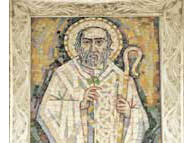Some scholars doubt that St. Patrick ever existed. They say that the Irish may have felt a need to create a powerful founder in order to glorify the origin of their church. Rome had Saints Peter and Paul; the founding of the church in England was definite, but muddy as to provenance; so, this argument goes, the Irish would do the British one better and find themselves a strong, saintly leader.
Perhaps the powerful Patrick and the legends about him (some are indeed quite fanciful) were invented and then placed upon the life of a much more ordinary missionary of that name. Heinrich Zimmer held this line of reasoning about a century ago in his book, The Celtic Church in Britain and Ireland:
It would not require a long stretch of imagination if we assume that, about 625 [when the first Life of Patrick was published], Ireland’s pious wish of having an apostle of her own was realized by reviving the memory of this Patricius, who had been forgotten everywhere except in the southeast. It was in this way, I think, that the Patrick legend sprang up with its two chief premises: first, that Ireland was entirely pagan in 432…and secondly, that Patrick converted Ireland within a short time and introduced a Christian Church, overcoming all obstacles and winning the favor of King Loigaire.
Zimmer’s is one response to the fantastic legends: Do not believe them at all; they must have been manufactured. But most scholars disagree with Zimmer. They say that Patrick not only existed but did some remarkable things, even if he was not the first missionary to Ireland.
Patrick’s two acknowledged writings are the Confession (written when he was an old man responding to charges made against him by British priests) and the Letter Against Coroticus (also polemical, written earlier). These are the only reliable witnesses to Patrick’s life and work. From these we know that Patrick’s Latin was not good; that his father was a deacon named Calpornius; and that Patrick’s grandfather, Potitus, was a presbyter in his village in Britain. At age 16 Patrick was kidnapped by pirates and taken to Ireland, where his faith was kindled while in captivity; he worked as a shepherd and heard the “voice” of God speak to him. After six years, he fled Ireland, stowed away on a ship. The ship traveled for three days until reaching land; Patrick visited his parents in Britain a few years after he escaped; he returned to Ireland and claimed to have baptized thousands of people.
If none of that sounds familiar, it is because you rarely see any of it in the iconography of the saint. The St. Patrick of art tells stories that move beyond what the experts say we can know for sure. Some of us heard legends of St. Patrick as children, and we repeat them to our own children. That great Irish poet of the last century, Patrick Kavanagh, wrote in “To Be Dead”:
And you perhaps, take up religion
bitterly
Which you laughed at in your
youth,
Well not actually laughed
But it wasn’t your kind of truth.
I do not think it harms anyone to believe that Patrick combated Druids in remarkable ways, that he performed magician-like miracles and all of the other stories that fill the pages of Jacobus de Voragine’s Golden Legend and Alban Butler’s Lives of the Saints. In art, Patrick is most often represented in these legendary ways.
Most often, Patrick is shown holding a bishop’s crosier, a serpent snaking around the length of it. Various legends exist as to how, where and when he was supposed to have obtained this staff. One legend intimates that Christ himself had once used it—hence one of the other names for it, baculus Jesu. Medieval believers latched onto Patrick’s comments in his autobiographical Confession about being divinely instructed in his mission as evidence that the crosier had been mystically passed from Jesus to Patrick, over a circuitous route spanning four centuries. Now there is a story to be told! It would be beautiful, whether true or not.
Patrick is supposed to have used that staff to beat the snakes, symbolizing heathenism and evil, out of Ireland. Other legends say that a black bell (which can still be seen in The National Museum of Ireland in Dublin) was the tool for driving the snakes away. For this reason, you will often see Patrick in paintings with a bell. Legend has it that Patrick rang this bell from the summit of Croagh Patrick and then threw it over the side of the mountain. Angels retrieved and returned the bell to him. Again and again this happened, and each time snakes and other crawling creatures fled.
There are no snakes in all of Ireland. Natural scientists tell us that, in fact, Ireland never had any snakes. When snakes first evolved from lizards about 100 million years ago (the same era as the first tyrannosaurs), they lived entirely on the southern continents. Meanwhile, the land that became Ireland was underwater. Sixty-five to fifty million years ago, when the climate of Earth changed, drying out, snakes quickly proliferated—but not by swimming across vast bodies of water to islands, such as Ireland, Greenland and New Zealand. Somewhat more recently, ice ages have eliminated snakes from northern continents, only to see them return again, but not across icy waters such as the English Channel or the Northern Channel, which separates Ireland from Scotland (where a few species can occasionally be found).
In the iconography of Patrick, two other traditional images appear: a three-petaled shamrock and a wind-swept scene. A shamrock is pictured most often in trinkets and on saint cards; it captures the story of when Patrick, who was always known to use ordinary things to make extraordinary points, picked up a shamrock to explain the Trinity to a group of pagans. The wind-swept imagery recalls a particular scene, as well as a nonparticular setting. The scene was the one preserved in the Golden Legend, when Patrick dug a circular hole with his staff, and the earth opened to reveal purgatory, demonstrating the existence of such a place and the necessity of being baptized. Hot air rushed to the surface and scared the people straight. The nonparticular setting, common in more contemporary illustrations of St. Patrick, shows him in the west of Ireland—the land to which, by most scholarly accounts, he may have genuinely been the first Christian missionary. Patrick probably spent many occasions standing on high and craggy bluffs in the west of Ireland, the wind buffeting and strengthening him.
Another image of St. Patrick intrigues me more than the others, and it is especially meaningful now, as Easter approaches. It is the image of Patrick on the Hill of Tara, the ancient seat of the Irish kings, where he lit the Paschal fire as a dramatic nighttime gesture (some of the greatest saints were also dramatic virtuosos) to sanctify the island for Christ. Look for this remarkable story in any major biography of the saint, and look to—of all things—a postage stamp for one of its most beautiful representations. The artist is unknown. The stamps were issued from Dublin in 1937, and you can see them on the Web page about notable events in postal history (http://shoebox.heindorffhus. dk/frame-StPatrick.htm).
Both the hard facts and the fanciful legends about Patrick have the power to fascinate and instruct; it is best to strike a balance between the two. Since so many centuries have passed, we will likely never know more about the man who was Patrick than we do today.








